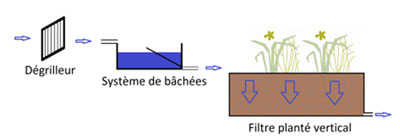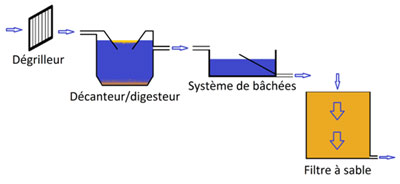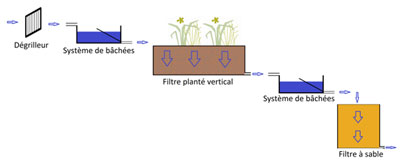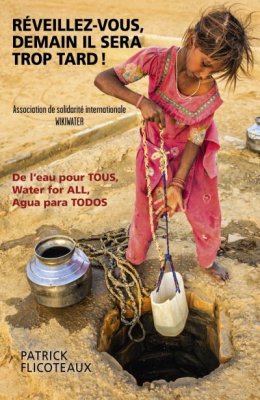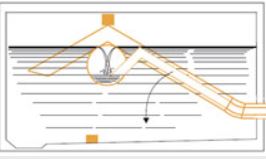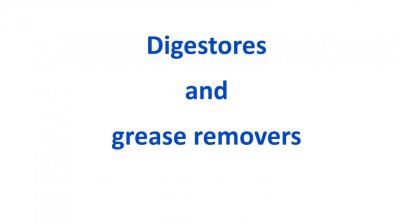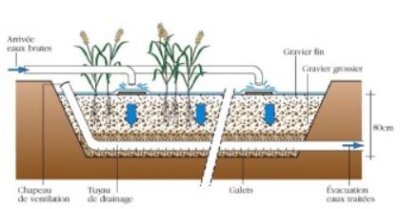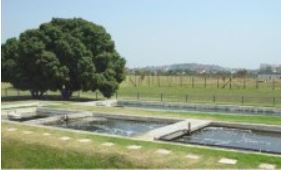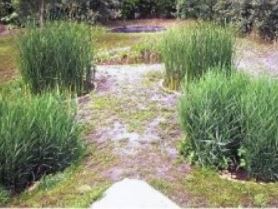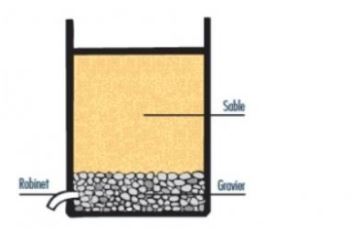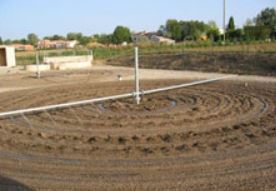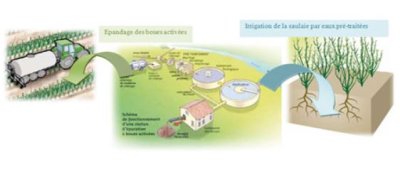1) What is involved ?
This fact sheet provides an overview of ecological effluent treatment systems, not involving an industrial treatment plant, which can be used in communities with populations ranging from a few tens to several thousands of people. These systems, which may be of quite different types, are essentially based on the use of planted filters, sand filters and lagoons. Their purpose is to ensure that the water discharged into the wild is clean enough to prevent the spread of diseases and the contamination of ground water. They in fact correspond to an assembled set of components that are almost always the same : lagoons, sand filters, macrophyte plant filters (reeds, etc.), preceded by screening systems, degreasing systems, tarpaulin systems or settlers/digesters.
- Fact sheet A18 : Trash racks and tarpaulin systems.
- Fact sheet A19 : Degreasing trays or settlers/digesters
- Fact sheet A20 : Planted filters or drying beds
- Fact sheet A21 : Lagooning techniques
- Fact sheet A22 : Sand filters
- Fact sheet A23 : Gravel pack treatment
This fact sheet explains how to assemble these components to obtain a treatment system meeting the needs of a given situation.
The technical details on how to install each component are given in the appended fact sheets above.
2) Why use this means ?
Mostly towns, with sufficient land nearby, in developed countries but also increasingly in developing countries, and sometimes in small towns in rural areas. Some systems are even used on a family basis.
3) Why ?
Because these systems can treat waste water at a lower cost, without having to use physical/chemical treatment system and industrial facilities as in conventional treatment plants. They purify water by natural biological treatment and allow it to be discharged into the wild without fear of polluting ground water or spreading diseases. The water thus purified can be used for irrigation, or even for creating fish ponds, as a source of income.
4) What are the main treatment sustems ?
The best known systems are lagoons and the use of filters planted with macrophyte plants, for which specific fact sheets have been drawn up. But there are in fact many possibilities for assembling purifying or filtering components, each corresponding to specific uses. The main examples of such systems are set out below.
| System |
Treatment capacity Number of inhabitants |
Required area Order of magnitude |
Appended fact sheets required |
| 1/ Vertical planted filter | 10 to 2000 | 4,5 m²/inhabitant | 18 and 20 |
| 2/ Series of vertical planted filters | 10 to 2000 | 9 m²/inhabitant | 18 and 20 |
| 3/ Combination of vertical and horizontal planted filters | 10 to 2000 | 7,5 m²/inhabitant | 18 and 20 |
| 4/ Settler/digester and sand filter | 50 to 2000 | 3 m²/inhabitant | 18 , 19 and 22 |
| 5/ Vertical planted filter and sand filter | 10 to 2000 | 7,5 m²/inhabitant | 18, 20 and 22 |
| 6/ Vertical planted filter and lagooning | 100 to 5000 | 7,5 à 10 m²/inhabitant | 18, 20 and 21 |
| 7/ Lagooning | 100 to 5000 | 10 à 15 m²/inhabitant | 18 and 21 |
| 8/ Lagooning and sand filter | 100 to 2000 | 6 à 8,5 m²/inhabitant | 18, and et 22 |
| 9/ Settler/digester and lagoons | 100 to 2000 | 8 à 12 m²/inhabitant | 18, 19 and 21 |
System No. 1 : Vertical planted filter
This system is the simplest and easiest one to set up. It can be used on a family basis. It does not allow the treatment of sewage, but grey water only. It treats water in a simple way.
System No. 2 : Series of vertical planted filters
In this system, the first stage consists of three filters in parallel and the second stage, two filters.
The recommended level difference on the land on which such a system is installed is about 4 metres. If not, the water has to be raised using a pump.
This system can be used to treat domestic grey water.
System No. 3 : Combination of vertical and horizontal planted filters
The horizontal filter needs less of a slope than the vertical filter. Two to three metres level difference is sufficient for this system. It is important for the water to flow first through the vertical planted filter : this stage is needed to prevent the horizontal filter clogging.
This system has been found to be more effective than the previous one in removing germs from faecal matter. It should thus be preferred for black water treatment (sewage + faeces + urine).
A variant of this system involves replacing the tarpaulin system and the vertical filter by a settler, which allows to system to be installed on land with a level difference of one meter. It can thus be used without a pump on less sloping land.
System No. 4 : Settler/digester and sand filter
This system is simpler to set up than most other systems. It allows the treatment of grey water and black water. The settler/digester is used as a pre-treatment system for the sand filter to prevent clogging and improve treatment efficiency.
Such a system takes up less ground space than other systems (about 3m²/inhabitant). It is thus recommended for suburban areas where there is not much space.
System No. 5 : Vertical planted filter and sand filter
In this system, the vertical planted filter is followed by a sand filter. As the effect of each of these components on waste water is not the same, the two treatments are complementary. It is important to locate the sand filter after the vertical planted filter to prevent the sand filter clogging.
Such a system allows the treatment of grey water and black water.
System No. 6 : Vertical planted filter and lagooning
This system also allows the treatment of grey water and black water.
It is often used when a pre-existing lagoon system (such as system No. 7) is no longer sufficient because of a growing population. A vertical planted filter stage can then be added upstream and sized on the basis of 1.2 m²/inhabitant and thus double the treatment capacity without taking up twice as much space.
System No. 7 : Series of lagoons
Such a system can be widely used for the treatment of grey water and black water. The number of lagoons can also be increased to provide better treatment.
Examples of such systems (source : www.globenet.org) :
1. In Rufisque, near Dakar, such a system treats the waste water of 5000 inhabitants (capacity of 105m3 a day). It takes up half a hectare in area. The first lagoon acts as a settling/digestion pit and is 1.85 metres deep. Six lagoons in series, covered with water lettuce, provide the rest of the treatment process. The total price of the system was 26 million CFA Francs. With a yearly depreciation of about 2 million CFA francs (€30,000), the revenue generated through the sale of purified water and compost will allow investment to be repaid over a period of six years and 15 workers to be paid up to 50,000 FCFA/month (€80/month) from the second year of operation.
2. Another example is the system in Mirzapur in Bangladesh, which treats about 6300 m3 of waste water a day. It consists of the following :
- Primary anaerobic lagoon 2.5 m deep on an area of 24 hectares (settling time of 24 hours)
- Duckweed lagoon over an area of 9000m². Duckweed can reduce the area needed while keeping the same quality. Duckweed forms a film covering the whole surface of the lagoon.
- Duckweed tertiary lagooning pond.
- Fish pond lagoon over an area of one hectare where carp, rohu, catla and other species are reared.
The operation of this system has created jobs requiring only very basic training. It allows fodder to be produced from duckweed and 6 tons of fish to be reared a year.
The initial cost of the system is 22,000 dollars.
System No. 8 : Lagooning and sand filter
In this system, which can be used to treat grey water and black water, a sand filter completes the treatment provided by the lagoons. As the sand filters take up less space than the lagoons, it provides a useful possibility for decreasing the size of the system.
Adding a sand filter downstream of the series of lagoons can improve the treatment of a pre-existing lagoon overloaded as a result of population growth (same remark as for system No. 6).
System No. 9 : Settler/digester and lagooning
A settler/digester can be installed as a pre-treatment system. This is a large container in which waste water settles for long enough to allow solid impurities to sink to the bottom and fats to rise to the surface. This improves the purification efficiency of lagoons.
In Thies, in Senegal, such a system with a capacity of 10m3 a day has been developed to treat the waste water from a slaughterhouse. The treatment stages are as follows :
- a degreasing pit (similar to the settler/digester) that decreases the amount of suspended solids by 30%
- A lagoon 2m deep with a surface area of 20m² corresponding to a flow rate of 10m3 a day for a settling time of 4 days
- A microphyte (micro algae) lagoon 1.2 m deep with a surface area of 180m², in other words a settling time of 22 days
- Two macrophyte (water lettuce) lagoons in series, 50 cm deep with a surface area of 200m², in other words a settling time of 10 days in each lagoon.
The quality at the plant outlet is very satisfactory and the water is reused by the slaughterhouse to clean skins.
The yearly depreciation of this unit is 400,000 CFA francs and the total overheads amount to 550,000 CFA Francs/year.
5) Possible use of water at the plant outlet
The water recovered at the outlet of a water treatment system can be discharged into a river. If its quality is sufficient, however, there are several ways of reusing it :
- Such water can be stored for reuse in irrigation
- It can be used to supply a fish rearing pond : see the example of the Mirzapur plant referred to in the paragraph on system No. 6
- It can be reinjected into the ground water : see fact sheet E 11 "Ground water re-supplying methods".
- It can be discharged into a willow or reed pond, which forms a buffer area in which its treatment continues, and that can be used for profit (depending on its size)
- Finally, it can be re-used for industrial or craft purposes.
6) Where to obtain further information ?
a) Websites
- EAWAG (Swiss research institute located near Zurich) : "Compendium of water treatment systems and technologies" very comprehensive, illustrated and informative 158-page book, which can be downloaded as a complete document or chapter by chapter (6) and pages 93 to 123 of which are devoted to the main semi-centralised, ecological waste water treatment methods, by clicking on :
http://www.eawag.ch/forschung/sande...
- Report of the Loire-Bretagne water agency on planted filters and other sanitation methods. Pages 27 to 34
http://www.arsatese-loirebretagne.a...
b) Bibliography
- PDM and PSEau SMC Methodological guide (concerted municipal strategies) : "Choosing suitable technical solutions for liquid waste disposal", which is a very interesting and informative 136-page illustrated guide produced by GRET, pages 110 to 127 deal with the problem of intensive treatment of septic drainage sludge and sewage.
This guide can be obtained from GRET (45 avenue de la Belle Hélène 94736 Nogent/Marne Cedex) or from PSEau (www.pseau.org)



